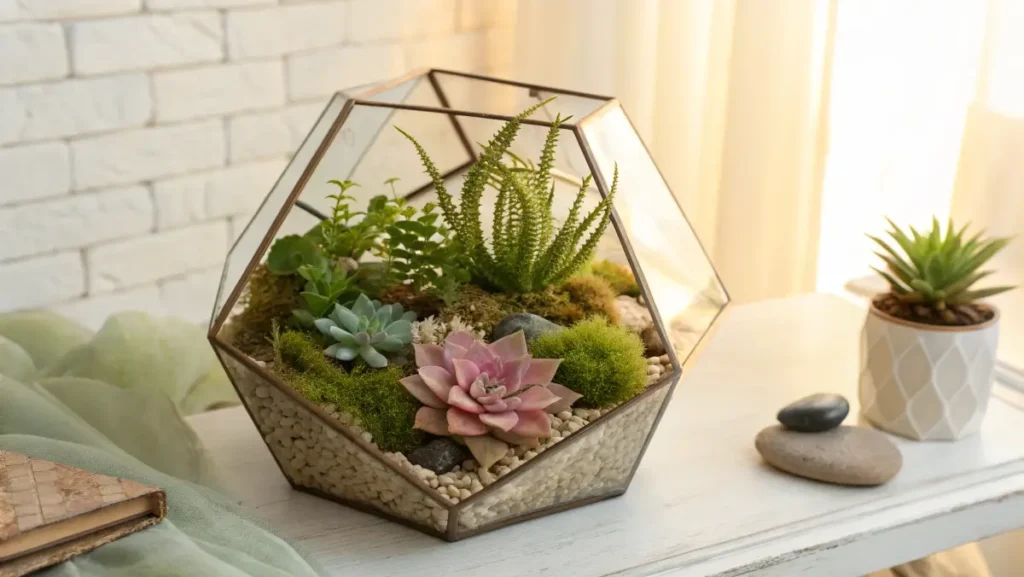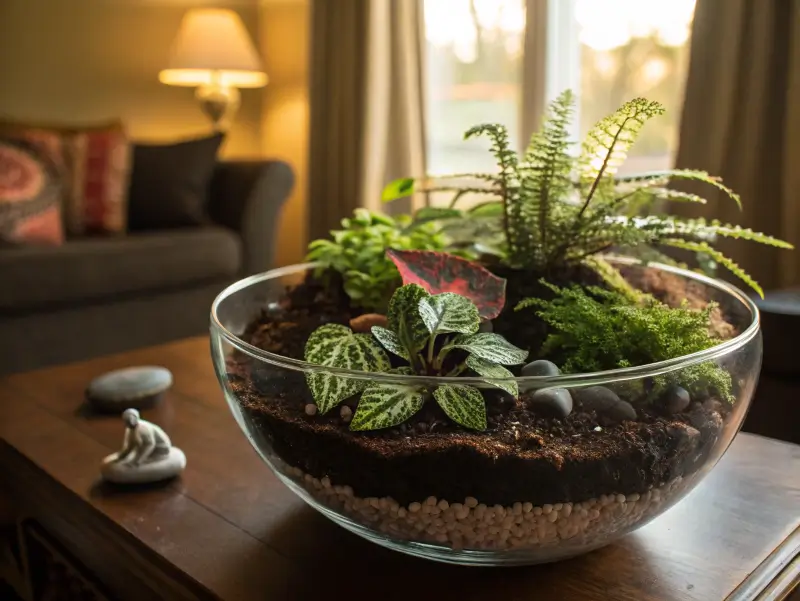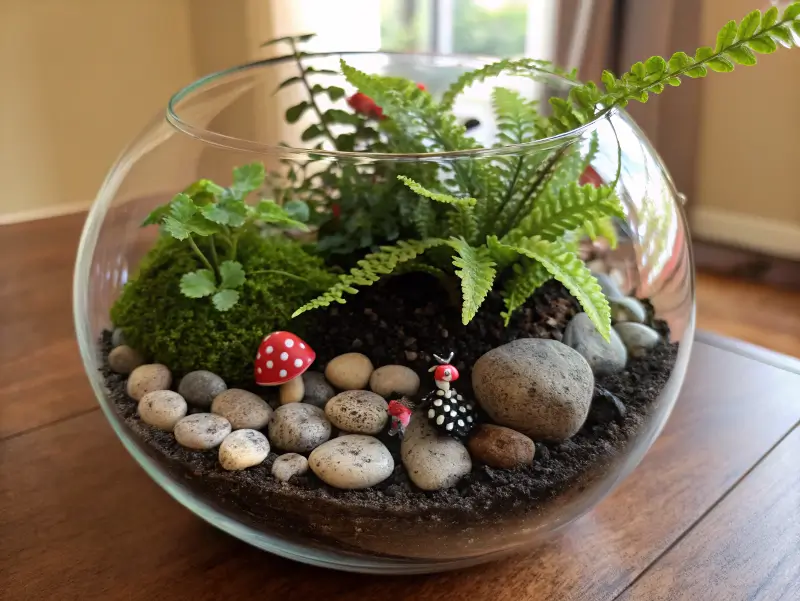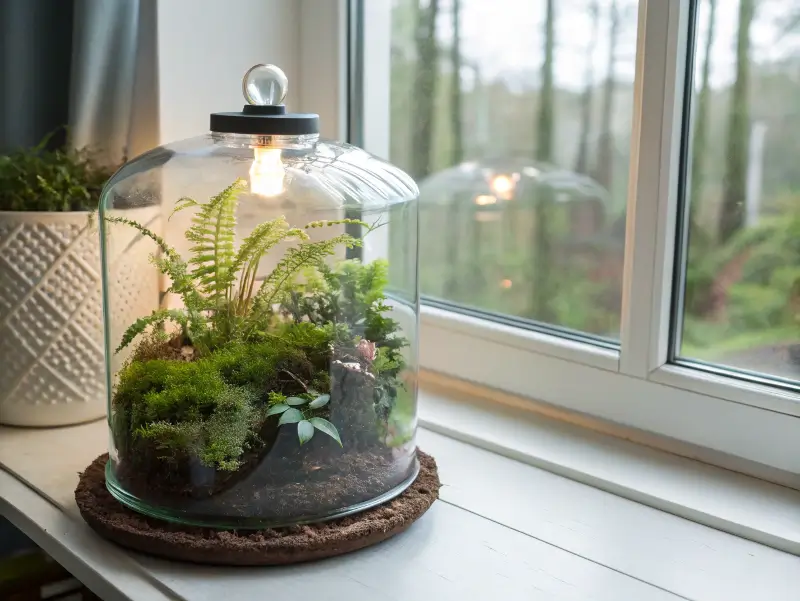
I love how terrarium plants brighten my home this spring with so many folks diving into stylish, do-it-yourself projects. In this post, I’ll share how to create mini gardens, highlight the top terrarium plants, and dish out neat tips for arranging them in fun containers. You’ll see how some folks craft a rainforest in a jar or go open-bowl style for succulents. Let’s dive into these glass wonders now!
Table of Contents
Introduction to Terrarium Plants
Understanding Indoor Gardens and Terrarium History
I remember seeing an old-school glass container at my aunt’s place years ago, filled with moss and baby ferns. At first, I thought it was just a quirky display, but it turns out it was a forerunner to modern terrarium plants. Back in the nineteenth century, people realized that a sealed glass jar could hold moisture and create a thriving environment for low-maintenance houseplants.
- Terrariums became big in Victorian times.
- People wanted to bring greenery indoors without making too much mess.
- The popularity comes from “mini gardens” that don’t require huge windows or large patios.
Why Terrarium Plants Are Trending
I’ve noticed this wave of interest picking up on social media. Honestly, folks want that splash of green indoors:
- Terrarium plants are perfect for small apartments or dorm rooms.
- Urban gardening trends make container gardening even more popular.
- They’re kind of mesmerizing to watch every day.
Choosing the Right Container for Your Terrarium
Open vs. Closed Terrarium Containers
When I first jumped into terrarium plants, I had to pick between open and closed designs:
- Open terrariums: Best for succulents and cactus terrariums that like airflow.
- Closed terrariums: Great for moisture-loving ferns, moss terrarium care, and tropical plants for humid settings.
Closed containers trap humidity (like a mini-rainforest ecosystem) while open ones let extra moisture escape. If you’re in a dry climate, an open container may require frequent misting.
Materials and Shapes: Glass Bowls, Jars, & More
I’ve used mason jars, large glass bowls, and fishbowl-like containers. I’ve even upcycled an old coffee pot. Here’s a quick container checklist:
- Clear walls let you see root and substrate layers.
- Wide openings help you plant and prune easily.
- Unique shapes (like geometric terrariums) add a modern twist to your decor.
Best Terrarium Plants to Grow Indoors

Popular Low-Light Terrarium Plants
My personal favorites for low-light spots include ferns and nerve plants (Fittonia). Ferns relish moist environments, and Fittonia stuns with colorful veins. Mosses are also a must if you want that lush, foresty floor.
- Ferns: Perfect for a closed terrarium environment.
- Moss: Elegant ground cover that sips humidity.
- Fittonia: Eye-catching pink or white stripes.
Miniature Tropical Houseplants for Small Spaces
If you’re itching for a more exotic vibe, try out:
- Polka Dot Plant: Adds pops of pink or white.
- Peperomia: Has thick, varied leaves that stay small.
- Tiny Bromeliads: Ideal if you crave a splash of bright color.
Sometimes, I’ll sneak in a Zebra Plant because it fits in compact containers and loves humidity. In a more adventurous mood, I’ll toss in a Curly Lipstick Plant for a playful, trailing look. Because these species stay relatively small, they won’t crowd your jar.
Essential Terrarium Substrates and Drainage Layers
Layering Pebbles, Charcoal, and Soil
Setting up the base is crazy important for terrarium plants. You need drainage since there’s no hole at the bottom:
- Pebbles or gravel: Collects excess water.
- Activated charcoal: Filters the environment and keeps odors down.
- Potting mix or peat moss: Encourages root growth and holds moisture.
This layering pebbles and activated charcoal approach is a tried-and-true classic. You can also add decorative rocks and gravel on top for a classy look.
Importance of Proper Drainage in a Closed Environment
I used to water my terrarium too much, leading to root rot and gnats. Now I follow a simple pattern:
- Add only small sips of water.
- Watch for condensation on walls (if it’s super foggy, crack it open).
- Scoop out any standing water if you spot it.
Design Principles for an Eye-Catching Terrarium

Creating Focal Points with Decorative Elements
I’m known to tuck small figurines or even crystals in my terrariums:
- Place a unique rock or driftwood piece in the middle.
- Add colored stones around your chosen focal point.
- Scatter moss around the edges for a natural vibe.
I enjoy putting a silly dinosaur figurine in the corner—just because it makes me smile every time I look at my terrarium plants.
Arranging Plants for Aesthetic Balance
A few quick pointers:
- Put taller plants toward the back.
- Cluster smaller plants in front for depth.
- Leave enough breathing room so plants don’t compete for light.
I once crammed too many nerve plants in a single bowl, and it looked like a jungle meltdown. Now, I leave some space for baby leaves to spread. You can also sprinkle in bits of orchid bark if you want a more tropical feel. And if you’re feeling wild, try layering some pretty marbles for color. It’s all about creativity, right?
Step-by-Step Guide to Building Your Terrarium
Planning and Gathering Materials
Before you dive in, get all your stuff in one place:
- Container: Decide on open or closed.
- Substrates: Pebbles, charcoal, potting soil.
- Plants: At least two to three terrarium plants you adore.
- Extras: Tiny decorations, gloves, and a little spoon for layering.
Clean the container so you’re starting fresh. To avoid leftover residue, I usually rinse it with mild soapy water and then let it dry fully.
Planting Techniques for Long-Lasting Results
I set up my layers like this:
- Pebble layer (about an inch).
- Charcoal layer (thin sprinkle).
- Potting mix (enough for roots to settle).
Then:
- Dig small holes for each plant’s root ball.
- Gently remove old dirt from roots.
- Secure plants in place with fresh soil.
I keep the soil slightly moist—like a wrung-out sponge—so the plants establish quickly. After that, I often mist the leaves. For an enclosed terrarium, I keep an eye on the glass. If I spot excessive condensation, I’ll crack the lid or open it for a few hours. This method keeps my terrarium plants from drowning in their own humidity.
Terrarium Lighting and Humidity Requirements

Natural Light vs. Artificial Grow Lights
My windows face east, so I get gentle morning sun—perfect for most terrarium plants. Too much harsh light can scorch leaves. If you’re stuck in a basement or an office with no windows, though, consider artificial grow lights for plants:
- LED lights with a full spectrum.
- Position them a few inches above the container.
- Run them for about 10 to 12 hours daily.
Maintaining Moisture for Healthy Terrarium Plants
Closed terrariums naturally hold moisture:
- If water droplets fully cover the glass, open it for ventilation.
- If leaves wilt, maybe the humidity’s too low, so add a spritz or two.
- Keep a small hygrometer if you’re really serious.
In a dry winter, forced heating can zap your terrarium’s humidity. I’ve combated this by misting once a day. On humid summer days, I hardly touch it at all. Honestly, it’s all about feeling the vibes of your terrarium and adjusting accordingly. Don’t sweat it—just open or close the container as it suits the plants’ needs.
Common Terrarium Challenges and How to Overcome Them
Dealing with Mold, Pests, and Overgrowth
Mold loves damp, dark corners. If you see little white fuzz on the soil:
- Scoop it out with a spoon or tweezers.
- Let things air out, maybe for a day.
- Check for soggy leaves or decaying matter.
Fungus gnats can show up if the soil stays too wet. I’ve used those sticky yellow traps to snag the adults. Overgrowth happens when your terrarium plants thrive so much they crowd out their neighbors. A quick snip with scissors solves that problem.
Adjusting Water and Light Levels
If the soil’s always soggy, reduce watering or add more drainage substrate. If you notice leggy growth, your terrarium plants might be craving more light:
- Move them near a brighter window.
- Use a grow light for a few extra hours.
Don’t panic if leaves turn yellow or brown. Sometimes it’s just older foliage making room for new sprouting leaves. Snip them off and keep rolling!
Advanced Terrarium Techniques and Styles
Vivarium, Paludarium, and Other Specialized Builds
Once you’ve mastered simple terrarium plants, you might get curious about a vivarium vs. terrarium or even a paludarium. A vivarium often includes small reptiles or amphibians, while a paludarium has land and water sections for aquatic life.
- Vivariums need enough ventilation for animals.
- Paludariums blend water features with plants.
It’s a next-level approach, but so cool if you’re into amphibians and fish. Just be sure to follow guidelines on healthy living for those creatures (the USDA has tips on responsible pet ownership if you want official resources).
Incorporating Water Features for a Unique Look
A little waterfall or trickling stream inside your terrarium can look awesome. But remember:
- Monitor algae growth.
- Change water regularly.
- Keep pumps clean and debris-free.
Water additions add a Zen vibe that might relax you after a long day.
Terrarium Maintenance and Long-Term Tips
Pruning and Replanting Strategies
I love that terrarium plants can be pruned right in the jar. When leaves get damaged or overgrown:
- Remove dead bits to prevent rot.
- Pinch new growth at the tips for bushier plants.
- Wipe the inside of the glass if you notice residue.
When some plants outgrow the terrarium, I gently lift them and transfer to a separate pot. That frees up room for smaller terrarium plants to shine.
Making Terrarium Plants Thrive Over Time
At least once a week, I’ll do a quick check. I look for:
- Moisture level in the soil.
- Any droopy or discolored leaves.
- Possible signs of pests.
I also rotate the container occasionally, so all sides get light. If you want to spice it up, you can add fresh moss or small ground covers. Sometimes, I treat myself by mixing in a new species—like a Curly Lipstick Plant—that suits a humid, glass enclosure terrarium design.
Frequently Asked Questions
What Kind of Plants Do Best in a Terrarium?
Most terrarium plants do well if they love humidity and don’t get huge. Ferns, mosses, polka dot plants, and baby tropicals like a warm, closed environment. Smaller succulents thrive in open terrarium ideas, though they like drier conditions.
What Not to Put in a Terrarium?
Avoid anything that demands full sun or becomes massive. Regular herbs like rosemary might struggle due to constant moisture. Also skip plants that sprawl rapidly, taking over precious space inside that glass jar.
How to Keep Plants Alive in a Terrarium?
Keep humidity balanced, watch mold, and remove dead leaves. Lightly water, but don’t flood the substrate. Let air circulate if you see dense condensation, and check the potting mix so it doesn’t stay soaked.
How Long Do Terrariums Last?
With proper care, they can last several years—sometimes even decades. There are stories of jars sealed for ages with terrarium plants trucking along happily.
